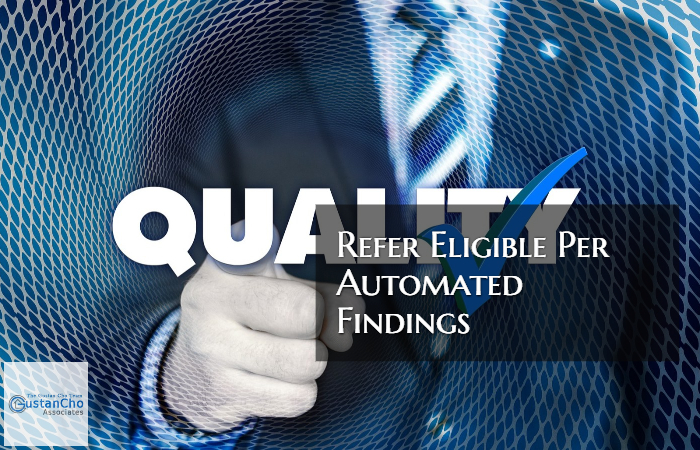What Is The Automated Underwriting System For Mortgages
The automated underwriting system (AUS) for mortgages is a sophisticated computer system used by mortgage lenders to see the results of the automated findings of FHA, VA, USDA, and/or conventional loans. The automated underwriting system takes in data entered by the loan officer and within seconds renders one of three automated findings:
- Approve/Eligible
- Refer/Eligible
- Refer With Caution
In the following paragraph, we will cover what each of these decisions mean to the lender and to the mortgage loan applicant.
Automated Underwriting System for Mortgages
The Automated Underwriting System, AUS, is a tool lenders use on government and conventional loans. There are two types of Automated Underwriting Systems. One is Fannie Mae’s Desktop Underwriter, the DU. The second is Freddie Mac’s Loan Prospector, the LP. Each of the two automated underwriting system has a sophisticated algorithm where it stores every aspect of HUD, VA, USDA, Fannie Mae, and Freddie Mac agency guidelines.
What Does Approve/Eligible Per AUS Findings Mean?
An approve/eligible per AUS means the mortgage loan applicant meets every aspect of the individual mortgage loan program agency guidelines.
What Does Refer/Eligible Per AUS Findings Mean?
Refer/Eligible per AUS means the automated underwriting system renders the mortgage loan applicant may or may not meet all of the agency mortgage guidelines. However, the AUS refers it to a human mortgage underwriter to manually underwrite the loan application. FHA and VA loans are the only two mortgage loan programs that can manually underwrite refer/eligible findings.
Refer/Eligible per AUS Findings on USDA Loans
USDA can manually underwrite refer/eligible files, but has to be through the U.S. Department of Agriculture Rural Development Guaranteed Loan Program. Manually underwritten USDA loans is underwritten by a USDA mortgage underwriter. Fannie Mae and Freddie Mac does not allow for manual underwriting on conventional loans.
What Is The Purpose of The Automated Underwriting System?
An underwriting system is an automated computer system that decides whether a person who wants a mortgage loan meets the minimum agency mortgage guidelines. These are for the Federal Housing Administration (FHA), Veterans Association (VA), United States Department of Agriculture (USDA), and Fannie Mae and Freddie Mac for Conventional Loans. This system is updated on all the recent guidelines on each loan type. It knows every aspect of each agency mortgage loan’s guidelines and regulations.
Speak With us about FHA, VA, USDA loan, click here
How Does The Loan Officer Use The Automated Underwriting System
The mortgage loan originator first takes the official 1003 mortgage loan application. The loan officer then runs a tri-merger credit report. A tri-merger credit report is a combination of three full credit pulls from each of the three major credit reporting agencies:
How Does The Loan Officer Use The Automated Underwriting System
Each of the three credit bureaus renders an independent credit score and full credit report. Lenders and the automated underwriting system use the middle of the three credit score as the qualifying score for mortgage qualification purposes. The data from the loan application and the loan applicant’s credit score and profile is entered into the automated underwriting system. Within seconds, the automated underwriting system renders one of the three findings.
What Happens After Automated Underwriting?
Your application, credit report, and other information are entered into the system. Very quickly, in minutes, the system will let the loan officer know if you qualify. It will tell the loan officer if it’s approved/eligible, refer/eligible, or refer with caution. Approve/eligible means the mortgage loan application is ready to proceed to the next level. Refer/eligible files will be evaluated whether the file is eligible for manual underwriting on FHA, VA, and USDA loans. Refer with caution means the file is dead and not eligible for a government or conforming loan.
What Are The Automated Findings of the AUS?
The loan officer will review the automated underwriting systems findings.
Approve/Eligible per the Automated Underwriting System
- This is what outcome you want!
- This means you meet all the agency lending guidelines on the loan you have applied for.
Refer/Eligible per the Automated Underwriting System
- You may be eligible for the mortgage. The system is not able to render an automatic approval
- However, if a professional mortgage underwriter underwrites the file, it can be approved.
- Only FHA and VA loans allow for manual underwriting.
- USDA automated underwriting system is GUS
- Manual underwriting on USDA loans is done through the USDA regional field office by a USDA Mortgage Underwriter
Refer to Caution per Automated Underwriting System
-
- This is not the desired outcome.
- It means that you do not qualify.
- This could be because you have not waited for the minimum timeframe after bankruptcy, a deed in lieu of foreclosure, foreclosure, or a short sale.
What To Do With a Refer with Caution finding?
The loan officer can analyze the findings, and if there were errors with inputting the data, dates were wrong, etc., they can resubmit. What will the loan officer try to do if you do not receive approval in the Automated Underwriting System? Not all loan officers are the same. It would be best if you found an experienced loan officer who can try to analyze what information prevented the rendering of an approval. It’s all based on the data that was entered. The loan officer can try switching to another system, entering a higher down payment, or adding cash reserves (if the borrower has them).
Qualify for Mortgage Loans by fill up your requirement, click here
Manual Vs. Automated Underwriting System
FHA and VA loans are the only two home mortgage program that allows manual underwriting. The main difference is in manual underwriting; there is debt to income ratio caps that FHA and VA recommend. There is no max Debt to Income ratio cap with Veterans loans when using an Automated Underwriting System approved/eligible. The maximum debt-to-income ratio recommended for manual underwriting on FHA and VA loans depends on compensating factors.
What are Compensating Factors For Manual Underwriting
Compensating factors are positive factors borrowers have that lessen lenders’ risk. Below are some examples of compensating factors.
-
- If the borrower has saved money
- The borrower has had a consistent job history with promotions and longevity.
- The borrower has cash reserves of at least three months
- There is a non-borrowing spouse with a full-time job
Debt-to-Income Ratio Caps for Manual Underwriting
FHA and VA manual underwriting guidelines on debt to income ratio caps:
- The maximum front-end debt to income ratio is capped at 31% and the maximum back-end at 43% with zero compensating factors.
- The maximum front-end DTI was capped at 37% and the back end at 47%, with one compensating factor.
- The maximum front-end DTI is capped at 40% and back-end DTI at 50%, with two compensating factors.
Mortgage underwriters can go above maximum debt-to-income ratio caps for borrowers with multiple compensating factors. This holds especially true for VA loans. Not all mortgage lenders do manual underwriting. If you are a mortgage loan applicant and need manual underwriting, please contact us at Gustan Cho Associates at 262-716-8151 or text us for a faster response. Or email us at alex@gustancho.com.
The team at Gustan Cho Associates is available 7 days a week, evenings, weekends, and during holidays. We are experts on manual underwriting and have no lender overlays on FHA, VA, USDA, and conventional loans. We are also experts in non-QM and alternative mortgage loan programs. Gustan Cho Associates is licensed in 48 states including Washington DC, Puerto Rico, and the U.S. Virgin Islands.
Frequently Asked Questions (FAQs)
- What is an automated underwriting system (AUS) for mortgages?
An automated underwriting system is a computerized program lenders use to assess a borrower’s creditworthiness and eligibility for a mortgage loan. It analyzes various factors, such as credit history, income, assets, and debt, to provide an initial loan decision. - How does the automated underwriting system work?
The automated underwriting system collects and analyzes the borrower’s financial information, which the lender inputs. It then compares this data against predefined underwriting criteria. It generates a decision, typically within minutes, indicating whether the borrower meets the requirements for a mortgage loan. - What information is used by the automated underwriting system?
The automated underwriting system considers a range of information, including the borrower’s credit score, employment history, income, assets, debts, and other factors relevant to mortgage lending. - What are the benefits of using an automated underwriting system?
Using an automated underwriting system streamlines the mortgage application process, reduces the need for manual underwriting, speeds up loan approvals, and provides consistent and objective decisions based on predetermined criteria. - Can borrowers with less-than-perfect credit use the automated underwriting system?
Yes, borrowers with various credit profiles can use the automated underwriting system. While it’s optimized for borrowers with stronger credit profiles, it can still provide decisions for those with less-than-perfect credit. However, they may face stricter requirements or higher interest rates. - Do lenders always follow the recommendations of the automated underwriting system?
While lenders typically give considerable weight to the recommendations of the automated underwriting system, they ultimately have the discretion to make manual underwriting decisions based on additional factors or borrower circumstances. - What happens if the automated underwriting system denies my loan application?
Suppose. In that case, if the automated underwriting system denies your loan application, the lender will provide you with a notice explaining the reasons for the denial. You may have the opportunity to provide additional documentation or address any issues the system identifies to overturn the decision. - Can I appeal the decision made by the automated underwriting system?
In some cases, borrowers may be able to appeal the decision made by the automated underwriting system by providing additional information or clarifying any discrepancies. However, the lender’s discretion ultimately governs the final decision. - Is the automated underwriting system used for all types of mortgage loans?
The automated underwriting system is frequently utilized for a range of mortgage products, encompassing conventional loans, as well as FHA, VA, and USDA loans. - Where can I learn more about the automated underwriting system and how does it impact my mortgage application?
You can discuss the automated underwriting system and its implications with your mortgage lender or broker. They can provide insights into the system’s workings and help guide you through the mortgage application process.
Speak With Our Loan Officer for Mortgage Loans






